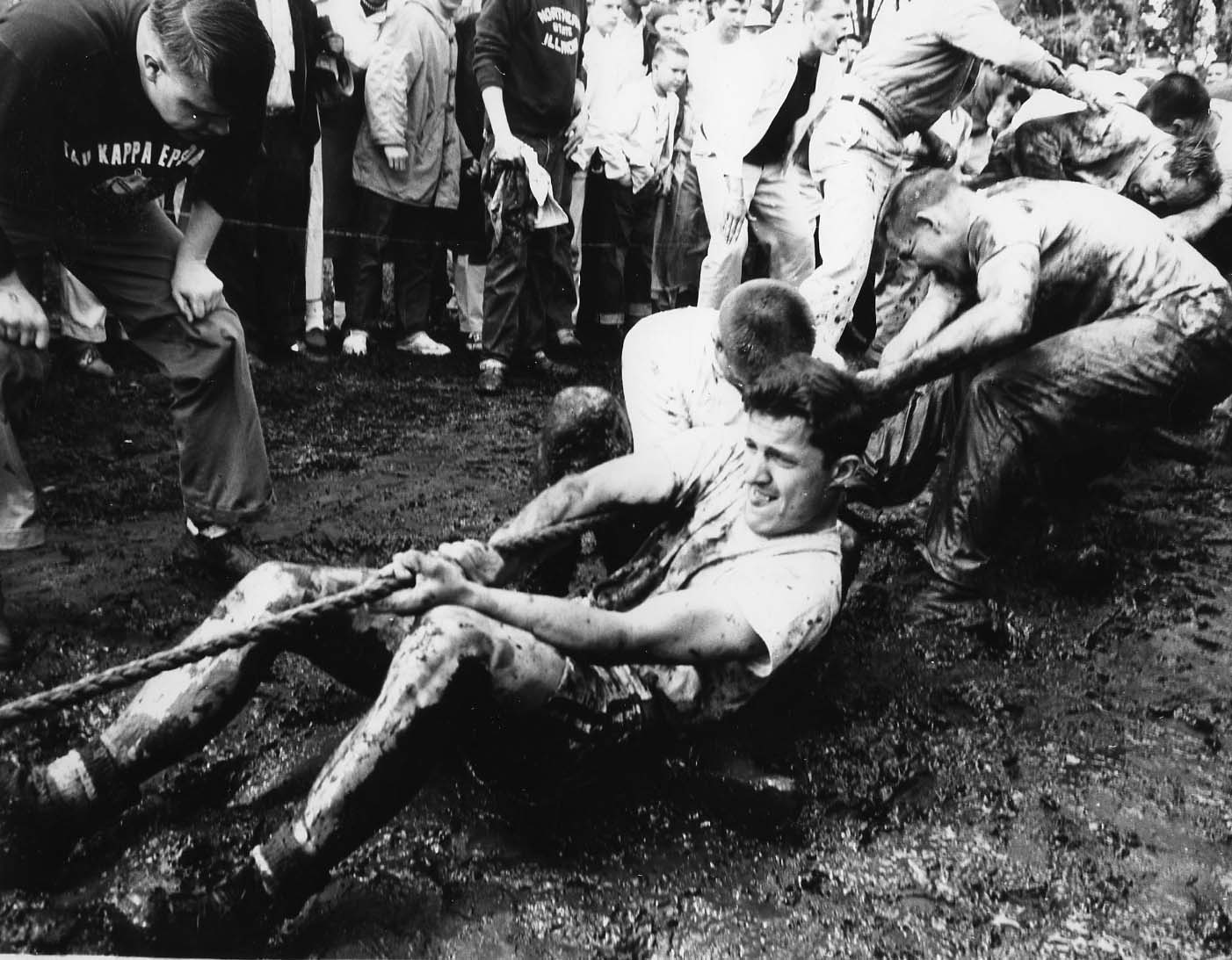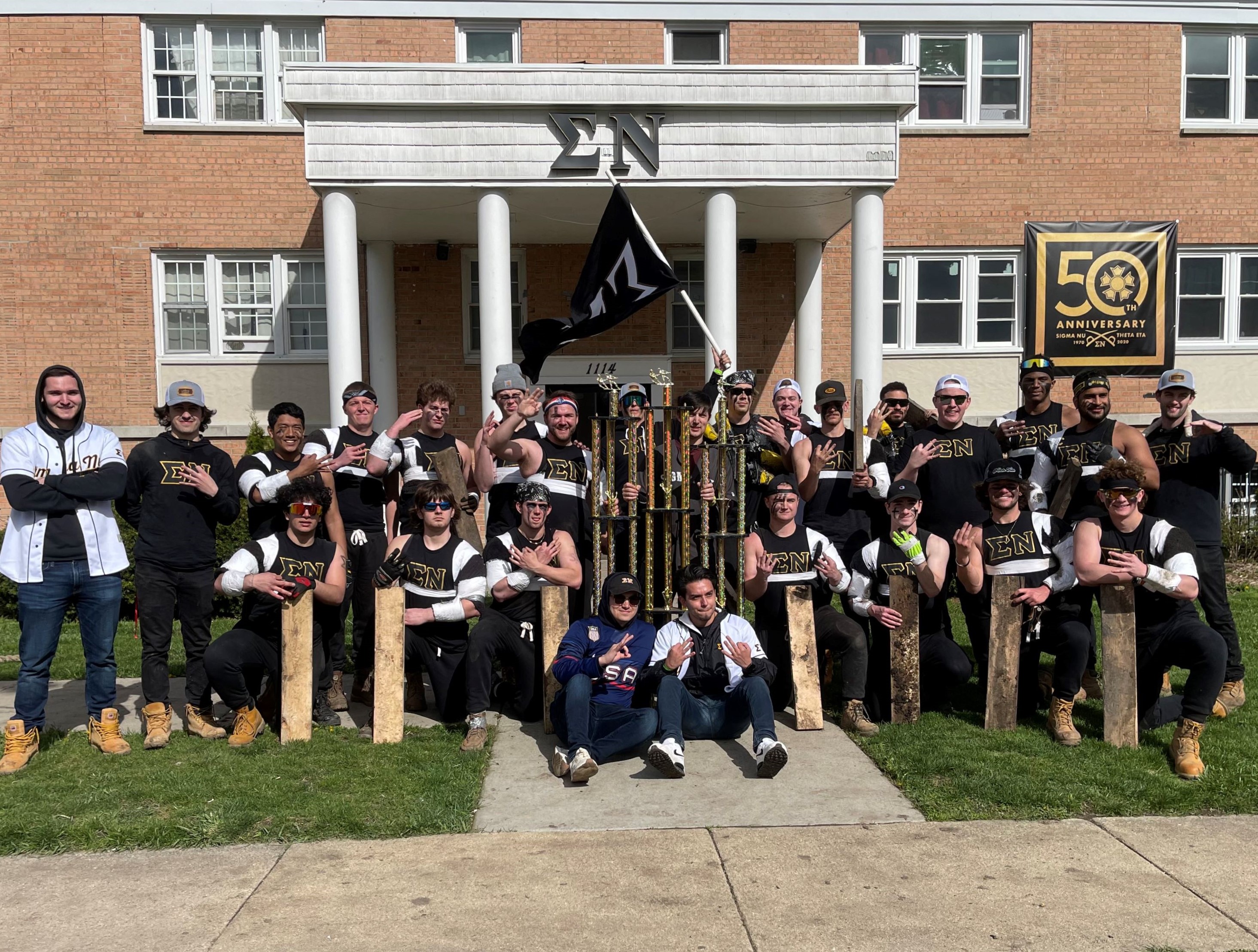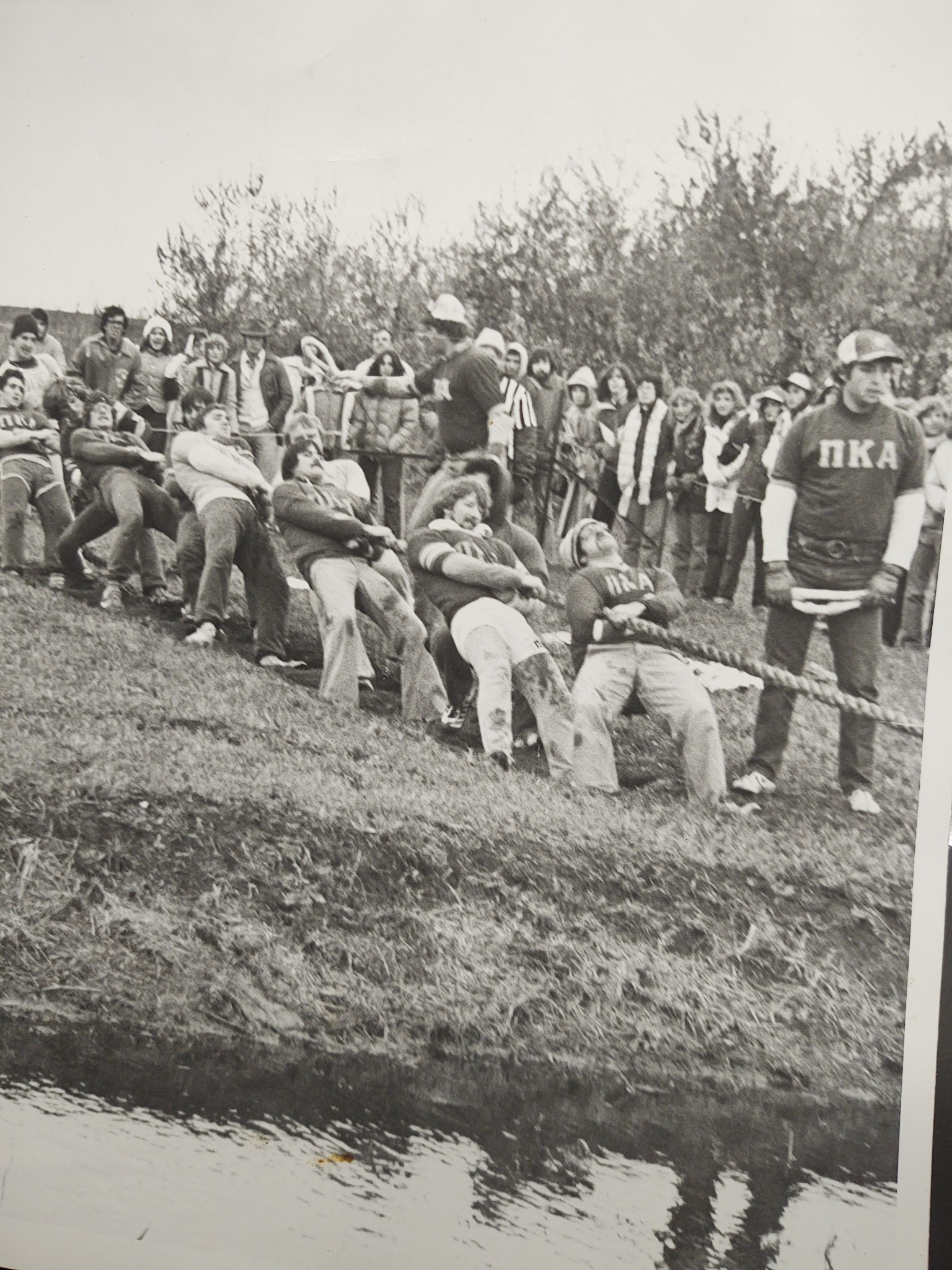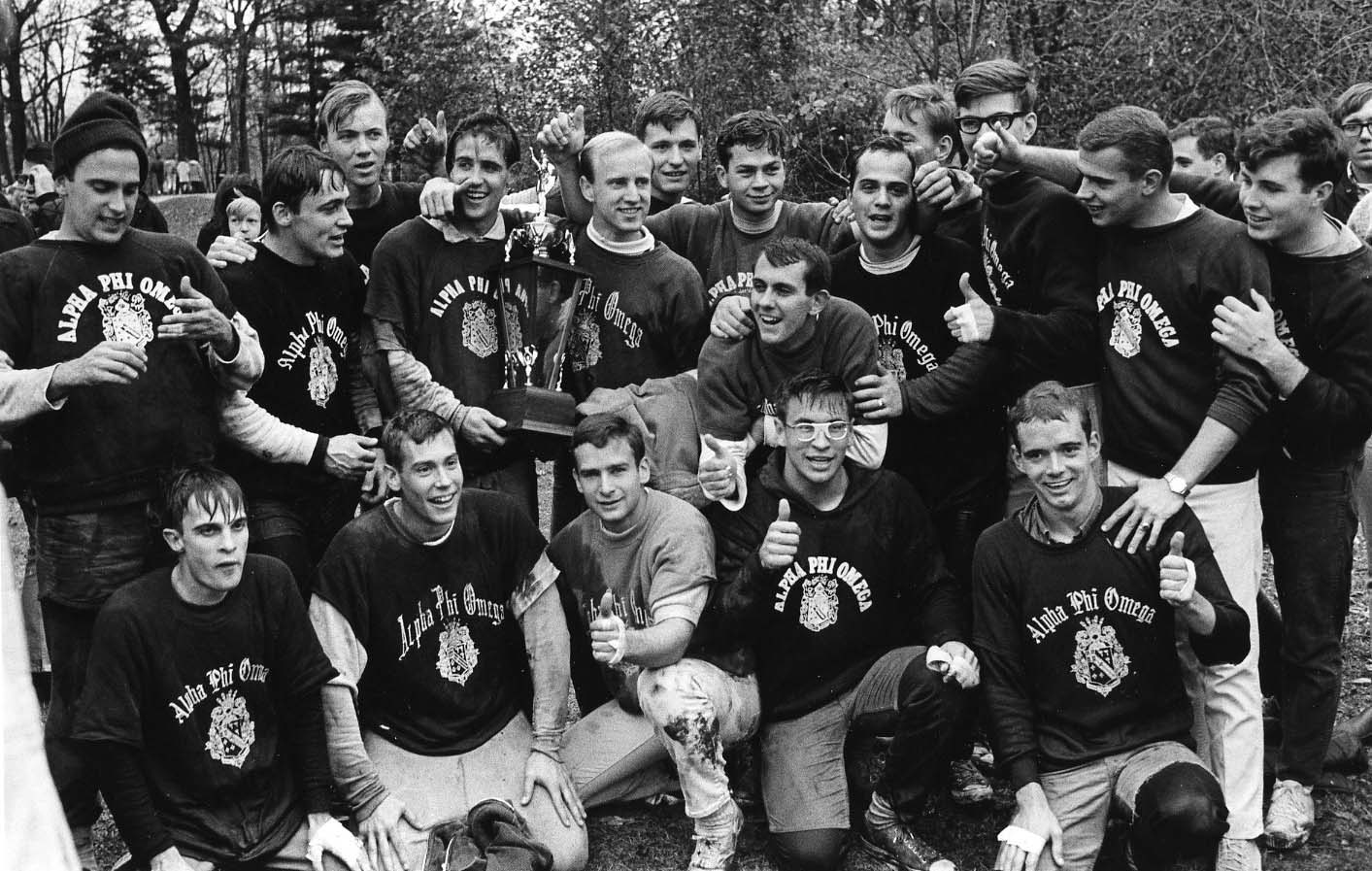Greek Alumni Cheer on Tugs, a Longtime, Competitive NIU Tradition
By Tony Scott
 A muddy tugs battle during NIU's May Fete celebration in 1958 featuring members of Tau Kappa Epsilon (TKE). (Photo from the Regional History Center and University Archives at NIU)
A muddy tugs battle during NIU's May Fete celebration in 1958 featuring members of Tau Kappa Epsilon (TKE). (Photo from the Regional History Center and University Archives at NIU)
Tug of war is a sport that goes back thousands of years to ancient China, Egypt, Greece and India. However, NIU has its own unique version of tug of war, known as tugs, that has its own history and, many Greek alumni hope, a bright future.
Tugs began on campus in the late 1940s and became a popular Greek tradition among fraternities and sororities into the 1950s and ‘60s. During those days, the tugs tournaments took place at the East Lagoon, with losers ultimately plunging themselves into the lagoon water. Over the years, it has moved locations until most recently the spring 2023 tugs tournament took place in the Greek Row neighborhood on Edgebrook Drive in DeKalb.
The fraternity tugs tournaments traditionally take place in the spring, typically April, while sororities have a tugs tournament in the fall, typically October. Proceeds for ticket sales to the fraternity tournaments, minus expenses, typically go to a charitable organization chosen by the Interfraternity Council (IFC).
Kevin Kedzior, ’92, is an advocate of continuing the tugs tradition and wants to see Greek alumni become more active and involved on campus. Kedzior hopes that a spring Homecoming tradition grows in the near future, similar to the traditional Homecoming in the fall, that revolves around tugs. He said he is hoping for an expansion of the beer garden and food trucks in the area during tugs to make it a dynamic atmosphere during the tournament.
There are tugs tournaments in Greek systems at universities throughout the country, but the style of tugs is unique to NIU. Rather than a flat surface tug-of-war, NIU tugs competitions feature a series of two-foot-by-two-foot trenches from which tuggers plant their feet to gain leverage and orchestrate choreographed moves to pull the rope toward their side. The ability to use leverage via the trenches makes NIU tugs a hard-hitting, violent sport.
 This past spring's tugs champions, NIU's Sigma Nu chapter. The chapter most recently won three tugs tournaments in a row.
This past spring's tugs champions, NIU's Sigma Nu chapter. The chapter most recently won three tugs tournaments in a row.The rope has a piece of athletic tape in the center, as opposed to a center line, ensuring that each side has an equal length of rope to begin. There is a 10-foot distance between the front of each team’s row of trenches. At the halfway point of this 10-foot span is a center marker stake in the ground flanked by two neutral zone stakes located six inches on either side of the center marker. At the end of each rope is a knot, which can be used as a measurement of victory.
To win a tournament, a team can win by advantage or win by knot. To win by advantage, a team has more rope on their side of the center marker at the end of 20 minutes. To win by knot, a team has to pull the entire rope, including the knot at the end, across the center marker. The team’s “first rope” and “second rope” each compete for 20 minutes. If no winner is determined after two ropes, the “first rope” tuggers take over again and tug in a “third rope,” winner-take-all match with no time limit. Winning is then determined by the team that combines for a minimum of one knot and one advantage score.
Kedzior said it takes a lot to win one championship, much less multiple championships in a row.
“It’s not just about the end result of winning – it’s about the process,” he said. “The process involves having a stable of physical talent, creating a training and coaching program to shape the talent, infuse this with the in-game strategy to manage a superior game plan. That’s to win once. To string decades of championships together, you have to develop the organizational culture and mindset which perpetuates the expectations necessary to win again and again.”
The tugs tradition has involved a variety of fraternities, but the most dominant was the Pi Kappa Alpha, or Pikes, fraternity between 1976 and 2009, which won 27 tugs championships. Two other fraternities won “three-peats” in the past 20 years: Sigma Phi Epsilon in 2005, 2006, and 2007, and Phi Sigma Kappa in 2012, 2013, and 2014; Phi Sigma Kappa has also placed in 16 straight tugs tournaments. More recently, the Sigma Nu house has won three championships in a row – 2019, 2022, and 2023 (the 2020 tournament was canceled due to COVID, and the 2021 event included only two teams due to COVID, with Phi Sigma Kappa as the winner).
The NIU tugs tournaments have traditionally involved 11-person teams, but the reduction of Greek memberships in the mid-2000s led to a reduction to nine-person teams. When the tugs tournaments resumed after the COVID restrictions, the teams were further reduced to seven-man and the time period to 15 minutes rather than the traditional 20 minutes. Kedzior, a passionate advocate for the tugs tradition, hopes the teams will one day go back to nine-person teams with 20-minute periods.
"Going from nine to seven men and 20 to 15 minutes has fundamentally changed the sport – how you train, how you condition, how you call matches," Kedzior said. "Seven-on-seven with 15-minute matches is a fraction of the standard. The standards must be restored.”
Raaif Majeed, ’23, was a frequent participant in the tugs tournaments as part of the Sigma Nu house. Each team has coaches and team leaders called “callers” to help guide the team. Majeed served both as a coach and a caller on the 2022 Sigma Nu championship team before returning to the rope as an arm tugger and team captain on the 2023 championship team.
Majeed said there is a level of mental and physical training that tugs participants must go through that lasts weeks and months in advance of the tournament in order to ensure victory.
“The most challenging part of preparing for the tugs tournament is instilling the mental toughness in your team that is required to win a championship,” Majeed said. “A high-caliber, championship-producing program is incredibly demanding on your body. The extreme levels of training that your body is regularly subjected to are far greater than what most people have ever experienced in organized sports. If an individual does not possess a certain level of mental toughness in order to go through the entirety of the season, there is very little chance that they would be able to compete for a championship.”
He added, “We would start our preseason during the last week of November and go until the end of the fall semester. Our regular season would begin during the first week of classes in the spring and go until match week. This would give us about 12 weeks of regular season training.”
Matthew Marconi, ’03, was a tugger and a caller during his days at NIU as a member of Sigma Pi. He said tuggers need to have 100 percent dedication to the sport.
“It is very hard and practice is painful,” he said. “Getting commitments from people to attend every practice and also go ‘dry’ for the semester was impossible for us. We would start practice in January. We would have wood trenches built and had a spot we could tie a rope to that would support our weight. We would condition by hanging against the wall as well as run speed drills to climb into our moves quickly.”
 Pi Kappa Alpha (PIKES) members in a tugs competition in 1979.
Pi Kappa Alpha (PIKES) members in a tugs competition in 1979.Like any physical sport, tugs can result in injury. Chris Cosentino, ’96, endured his share as a Pike participating in tugs tournaments in the 1990s.
“Tugging was physically grueling and it took its toll on the body,” he said. “In '95, I actually tore some of the muscles off my rib cage while practicing and had to go off the rope for a week to recuperate. That was not fun.”
Cosentino recalled the mental pressure of being a caller during those days.
“Calling was tough mentally because I had a lot of people in my ear and I was still relatively young,” he said. “There was a lot of alumni pressure to do well (especially in the Pike house), but I kept as much of a measured approach as possible.”
Cosentino remembered the highs and lows of the tugs tournaments that involved winning and losing tough matches. He said the experience was important as a young college student and taught him life lessons.
“It teaches one about defeat and how to accept it and how to learn from it, and, in more ways than one, it demonstrates the old adage that adversity builds character,” he said. “If it was easy, everyone would have done it. But it was probably the single hardest sustained physical activity I ever engaged in; or ever will again at almost 50 years old.”
The Greek alumni who participated in tugs say it’s a misunderstood sport that involves mental toughness and strategy, not just brute strength.
“You could have the 11 strongest guys on a rope who know how to 'pull really hard' but if they are not completely in sync, they are only going to go so far,” Cosentino said. “It teaches you how to work with others, communicate with them and go through all of the toil together.”
Majeed said those who don’t participate in tugs don’t understand the strategy, intensity and processes that yield success in a tournament.
“The process of winning a tugs championship is very long and extensive,” he said. “It requires about 20 athletes who are in top physical shape and have the appropriate physical characteristics (height and weight), a program that develops extensive muscular/cardiovascular conditioning along with technique, and callers who have the ability to understand the sport at an elite level. Those are just all the pieces that you need. Then, they all need to come together over a four-month period to produce a team that is capable of winning.”
The alumni said tugs experiences have affected their lives in positive ways and continue to impact how they live their lives.
“Most of the friends I have to this day are people that I tugged with,” Marconi said. “The tugs team is almost like a fraternity within the fraternity.”
Majeed said the tournaments strengthen the already-tight bond between fraternity brothers.
“Tugs, as a tradition, has always held a strong reputation for bringing individuals together,” he said. “Just as athletes in other team sports develop a high level of fellowship amongst each other, tugs has a similar effect, only heightened. When you are competing for the letters on your chest, you are competing for an organization that is more than a brotherhood. It is truly a family of individuals that you live with, eat every meal with, and spend the most transformative years of your life with. The bond that is created amongst that group of people transcends any level of camaraderie that most people ever get to experience with a group of people.”

